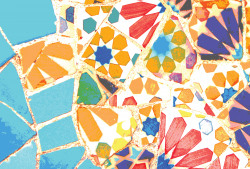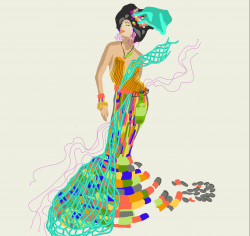The advertisements for the Corcoran Gallery’s new exhibition, American Evolution, juxtapose two iconic images—Gilbert Stuart’s portrait of George Washington and Andy Warhol’s silkscreen of Chairman Mao—in an irreverent, catchy pairing. So I expected the exhibition to be a series of attempted “evolutionary” links between American works of art, but the Zedong-Washington alliance is actually the only one of its kind there. American Evolution might have used the iconic images to lure tourists into its convenient location across the street from the White House, but its real message is to be that the visual history of American myths created by our art are often accepted as reality—a reality which sometimes needs to be challenged.
Divided into five overarching themes—Money, Land, Politics, Cultural Exchange and The Modern World—the 200-piece exhibition acts as a history textbook written in paintings and sculptures of the time periods. Although much of the task of a curator is putting together a collection of relevant works, giving them context in an engaging way is what really makes an effective show. Curators Emily Shapiro and Sarah Newman excelled at this by explaining not what school a particular painting belongs to, but instead how the public reacted to the painting. This comes across both through traditional placards next to the works and audio tour that lets you hear an expert discuss a piece on your cell phone; narrators range from the director of the Andy Warhol Museum to Project Runway’s style guru Tim Gunn.
The Corcoran owns all of the pieces in American Evolution, and the museum doesn’t hesitate to remind you of that. But instead of coming across as shameless self-promotion, it actually makes a point about our conception of art: we only see what museum boards and affluent collectors have decided to purchase.
In the Money section, for example, a room full of portraits of extravagantly rich 18th-century Americans looks like countless other rooms in countless other museums, but the accompanying explanations focus on the fact that these were the only people who could afford their own likenesses, making portraits a status symbol. Another room contains the works of artists like Winslow Homer, who painted people who couldn’t traditionally afford to be painted. His “Sketch of a Cottage Yard,” which depicts three people sitting on a porch of their semi-dilapidated house, now regains a sense of subversiveness, because you can see how the privilege of being painted is suddenly available to everyone.
One of the most effective presentations in the entire exhibit is Frederic Church’s “Niagara,” painted in 1857. An extremely realistic oil painting of the falls from the perspective of one just about to go over them is enjoyable to look at, but perhaps could be easily forgotten if crowded amongst other perfect-looking landscapes. Here, though, the painting is given its own room and surrounded by quotations on the walls from contemporary newspapers, which express their awe at “seeing” such a natural wonder for the first time. Church’s image, the placards explain, instigated America’s obsession with the falls, which eventually turned into the tacky tourist destination we think of it as today. In 1857, it was a breathtaking experience that could only be dreamed about.
With these and other iconic works of art in mind, the exhibition introduces its strongest theme: breaking apart the myths created by these works. One example of this is Gordon Parks’ “American Gothic, Washington, D.C.,” which parodies the recognizable original “American Gothic.” His version puts a masculine-looking black woman with a broom in front of the American Flag, making us reconsider the use of a white, heterosexual couple as a paragon of American art in the last century.
American Evolution, instead of focusing on the art itself, focuses on our reactions to it. In controversial artist Kara Walker’s “Roots, Links, Inc.,” meticulously crafted black silhouette on a white background lull us into enjoying for a moment the playful scenes because we’re used to the innocence of this Victorian-looking style; only slowly do we realize that the subject matter is actually grotesque, violent and sexually demeaning racist stereotypes used by whites to depict black slaves in the 19th-century South. Exposing the ease with which the pillars of American art can make us unquestionably assume one commonly accepted history is difficult, but important, for our culture to work through its problems, and the Corcoran has subtly pushed its visitors to do just that.
The Corcoran Gallery of Art is located at 500 17th St. NW, three blocks south of the Farragut West Metro. Admission is $10 for students. Visit corcoran.org for more information.




